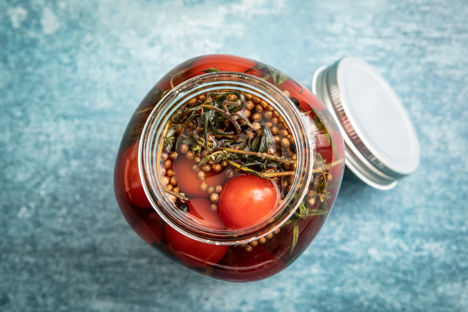Fermented cherry tomatoes have a tangy and complex flavour profile, perfect for adding to salads, fish dishes and sauces. They are made by storing cleaned cherry tomatoes in a brine solution made with salt and sometimes herbs or spices for an extended period of time - typically around two weeks. This process allows the beneficial bacteria such as lactobacilli to thrive and break down the sugar and starches in the tomatoes. The result is a slightly ‘fizzy’ tomato with an enhanced flavour that is incredibly versatile.
How do you ferment cherry tomatoes?
To ferment cherry tomatoes, choose ripe and firm tomatoes. Wash them thoroughly and pack into a clean, sterilised jar. Next, prepare the salt brine solution. Typically brine solutions range from 2% to 5%, which refers to the percentage of salt used in relation to the amount of water in the brine. For example, a 5% brine solution uses 50 grams of salt per 1 litre of water. Once the brine is prepared, pour it over the tomatoes, ensuring that they are fully submerged.
At this point, you can add herbs such as thyme or rosemary, along with whole spices such as star anise or black peppercorns. Finally, cover the jar with an airtight lid, and leave in a cool, dark place for 8-10 days. Open the jar daily to release any built-up pressure from the gas produced during fermentation. This process is known as ‘burping’.
How do I store fermented cherry tomatoes?
During the initial fermentation process, store the jar in a cool, dark place such as a pantry or store cupboard. Slightly warmer temperatures help to promote the fermentation process so after around 8-10 days, once you have reached the desired level of ferment, store the jar in the fridge to slow down the process and enjoy your probiotic-rich fermented cherry tomatoes.
What can you add to fermented cherry tomatoes?
Adding herbs and spices to fermented cherry tomatoes is a great way to be creative with flavours and increase complexity of flavour. Popular additions to ferments also include black peppercorns, red pepper flakes, rosemary and bay leaves.
Fermented cherry tomato recipe
Metric
Imperial
- 450g of cherry tomatoes
- 2 sprigs of fresh thyme
- 1 tbsp of black peppercorns
- 1 tbsp of chilli flakes
- 500ml of water
- 20g of flaky sea salt
Begin by washing the cherry tomatoes thoroughly
Prepare the brine solution by dissolving the sea salt in the water
Place all the cherry tomatoes into a clean, sterilised jar
Add the thyme, black peppercorns and red chilli flakes
Pour the brine solution over the cherry tomatoes until they are fully submerged
Cover the jar with a lid, then store in a cool, dark place and leave to ferment for 8–10 days
Open the jar twice a day, to release any gases from the fermentation process
After the initial fermentation is complete, taste the tomatoes and if they have reached your desired level of tanginess, transfer to a fridge to slow the fermentation process
What makes fermented cherry tomatoes different from pickled cherry tomatoes?
Though fermented cherry tomatoes and pickled cherry tomatoes may appear similar, they differ significantly in their preparation methods and flavour profiles. A common misunderstanding is that pickling and fermenting is the same process, however they could not be more different. Fermentation involves the breakdown of natural sugars and starches by promoting the growth of beneficial bacteria and yeast, resulting in a tangy flavour and the production of probiotics. By contrast, pickling involves preserving food in an acidic solution - typically vinegar based - which halts the growth of all bacteria and gives the food a characteristic sour taste. Fermented cherry tomatoes rely on the natural fermentation process to acquire their complex flavour profile, whereas pickled cherry tomatoes acquire their taste mainly from the acidic brine.
What are the benefits of cooking with fermented cherry tomatoes?
There are many benefits to cooking with fermented cherry tomatoes; flavour-wise they develop a tangy, complex taste with hints of fizzy sweetness, making them a versatile ingredient. Whether you use them to elevate salads, sandwiches, pasta dishes or even cocktails they are a great way to take your cooking to the next level. In terms of health benefits, fermented foods are rich in probiotics which support gut health.
Piccolo cherry tomato recipes
Piccolo cherry tomatoes are an incredibly versatile ingredient, whether they are fermented or used in a wider range of dishes. Why not try Pascal Aussignac’s Piccolo tomato tart, or Richard Bainbridge’s Piccolo tomato tartare? Along with fermenting, you can try semi-drying Piccolo cherry tomatoes, or even confit Piccolo cherry tomatoes which add a silky, luxurious quality to many dishes.
Get in touch
Please sign in or register to send a comment to Great British Chefs.


